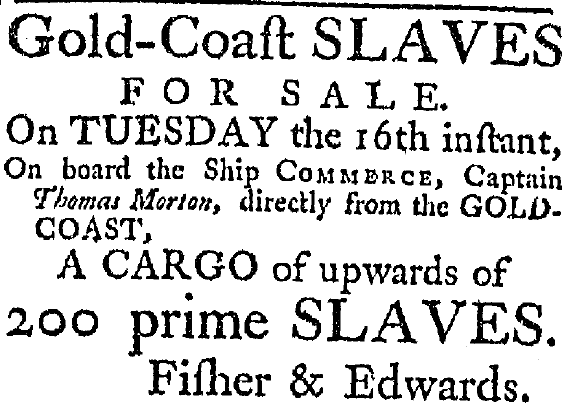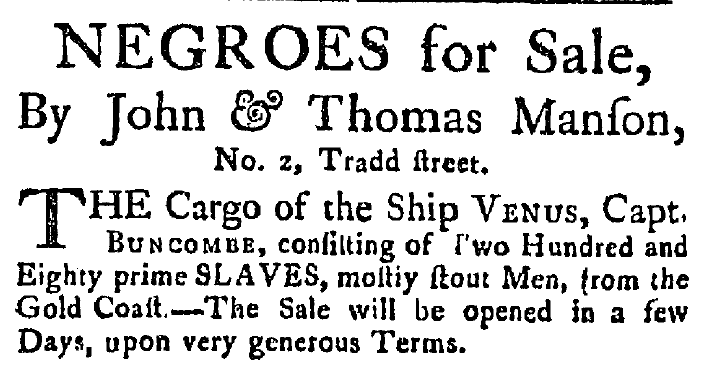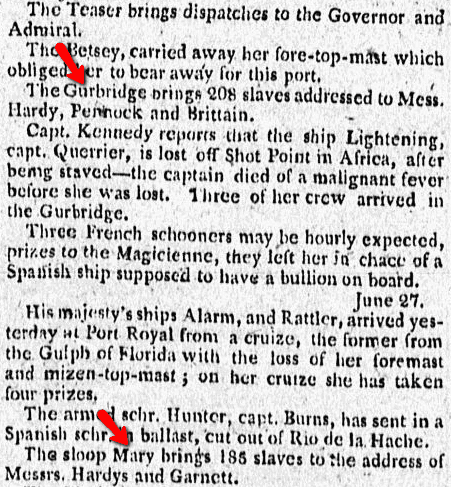Introduction: In this article, Gena Philibert-Ortega searches old newspapers and other online resources to learn more about the African slave trade in America. Gena is a genealogist and author of the book “From the Family Kitchen.”
Throughout the course of the Atlantic Slave Trade, an estimated 12 million Africans were captured in their homeland and forcibly shipped across the Atlantic, on more than 35,000 voyages, starting in the 17th century* The African Diaspora scattered Africans throughout the Caribbean and Americas. The first slave ship to land in Colonial America went to Jamestown, Virginia, in August 1619. The name of the first African slave ship out of the United States was Desire, which sailed out of Massachusetts eighteen years later. This forced migration caused the displacement, torture, enslavement and murder of many Africans.**
African slaves brought to the Americas were part of the “Middle Passage,” a voyage that began in Europe, stopped in Africa to unload supplies and pick up enslaved human cargo, and then traveled to American ports on the eastern coast to trade that human cargo for goods that were then shipped back to Europe.
History of the African Slave Trade in Early America and the United States Infographic (Note: the article continues after this infographic.)
This troubling part of American history—and important part of African American history—can be uncovered and explored with patient historical research, including searching in old newspapers such as GenealogyBank’s online Historical Newspaper Archives.
Laws Slow—but Don’t Stop—the African Slave Trade
It would seem that the African slave trade to America would have been stopped by a law passed by the U.S. Congress in March 1807 that stated:
“That from and after the first day of January, one thousand eight hundred and eight, it shall not be lawful to import or bring into the United States or the territories thereof from any foreign kingdom, place, or country, any negro, mulatto, or person of colour, with intent to hold, sell, or dispose of such negro, mulatto, or person of colour, as a slave, or to be held to service or labour.”***
Genealogy Tip:
Read more about U.S. legislation in the 1800s regarding slavery in GenealogyBank’s Historical Documents section which contains The American State Papers and more.
However, the Act to Prohibit the Importation of Slaves and a similar law passed in the United Kingdom didn’t end the practice of the slave trade. Slave ships illegally continued to bring their human cargo to U.S. ports, and American newspapers continued reporting on the occasional capture of a slave ship into the 1840s. (Two ships, the Wanderer and the Clotilde, are reported to have brought slaves to the United States well into the 1850s.) As with the passage of most laws, those who would break the law don’t end their criminal deeds; instead a black market thrives.
Slave Advertisements in Newspapers
Eighteenth-century newspapers found in GenealogyBank’s archives report of the comings and goings of slave ships, when the African slave trade was still legal. From advertisements to shipping news articles, researchers can find mentions of slave ships names, their captains, and descriptions of the people on board.
In some cases, advertisements for the upcoming sale of slaves included information on the ship they would be arriving on. In this example from a 1785 South Carolina newspaper, Fisher & Edwards advertise that the ship Commerce, under Captain Thomas Morton, will be arriving from Africa’s Gold Coast with “upwards of 200 prime slaves” for sale.

An earlier South Carolina advertisement proclaims that the slaves aboard Captain Buncombe’s ship Venus are “mostly stout men.”

Slave Ship “Shipping News” in Newspapers
Articles under “Shipping News” or “Marine List” headlines are a good place to start searching for information about slave ships, crew, and cargo.
In this example from a 1799 New York newspaper, we see updates on various ships including information about deaths on ships. We also see that the Gurbridge and Mary were bringing slaves, and to whom they were being brought.

Where to Find African Slave Trade & Slave Ship Records
- After exhausting your research in newspapers, learn more about a particular slave ship by consulting the Trans-Atlantic Slave Trade Database website, which houses information about slave ships from 1514 to 1866.
- In some cases digital collections may hold slave ship manifests, such as this example from the Metropolitan New York Library Council Digital Collections.
- Don’t forget to look for finding aids like this one from the New York Historical Society’s Guide to the Slavery Collection 1709-1899.
The National Archives (NARA) houses resources that can assist in your research, such as:
- The Slave Manifests of Coastwise Vessels Filed at New Orleans, Louisiana, 1807-1860 website has “manifests filed with the collector of customs at New Orleans, Louisiana, of slaves transported in coastwise trade to or from New Orleans during the period 1807-1860.”
| African American Slave Trade Infographic Research Sources: |
These online websites can be helpful, but research on the name of a slave ship should begin with historical newspapers. It’s in their advertisements and news articles that you will find mentions of the slave ships’ cargo, crew, and destination. You are free to share the History of the African Slave Trade in Early America and the United States Infographic on your blog or website using the embed code below. __________________ * The Trans-Atlantic Slave Trade Database. http://www.slavevoyages.org/tast/index.faces. Accessed 23 February 2014. ** “March 2, 1807.” This Week in History, March. http://www.peacebuttons.info/E-News/images/peacehistorymarch.htm. Accessed 23 February 2014. *** “An Act to Prohibit the Importation of Slaves into any Port or Place Within the Jurisdiction of the United States, From and After the First Day of January, in the Year of our Lord One Thousand Eight Hundred and Eight.” The Avalon Project. Yale Law School Lillian Goldman Law Library. http://avalon.law.yale.edu/19th_century/sl004.asp. Accessed 23 February 2014. |


Great research. Much appreciated.
The May 1861 Contraband decision by General Butler at Fort Monroe during the beginning of the Civil War was a significant change in slavery in America. It should be included in future revisions to this great infographic.
While the contraband decision did not free slaves, it began the practice of not returning runaway slaves to their owners as required by US law of the time and offered safe haven to hundreds of thousands slaves behind the lines of Federal forces. It is very significant as it help lead Abraham Lincoln to issue the Emancipation Proclomation.
I would like to know where I come from.
Wendell- The best place to start, is to start with what you know. Start with parents and grandparents and go back. If your parents or grandparents are still living, ask them about their parents and grandparents. You will want to research where they lived and their customs. Searching census records can answer some of these questions and give you a general idea of dates, places and siblings. Newspapers have obituaries that give family names, relatives and places. A good website to start with for census records would be FamilySearch.org.
Some praiseworthy research, but the number of Africans impacted by the Ma’afa is closer to 112 million and upwards of 230 million including children in utero and future offspring. 6 million is a gross understatement and a factual misrepresentation.
According to the Voyages database, the total between 1514-1875 to ALL countries and regions was 9,901,365. Can you tell me where you got your numbers?
I am unable to access the Voyages database… Any idea if it is still up and running?
It’s said that my family arrived from south Africa?
How many slaves came from West Africa? I started my ancestor tree in 1988 and could only go back as far as 1835, Prince Frederick, Calvert County, Maryland. My father said his ancestors were Tutsi and Native American. Can you point me in the right direction?
Disturbing — but are these facts based on actual written records found with proof, or just made up theories and insights on maybe what happened? So much has been hidden and erased on purpose. Is there really proof of the ships, and the census of slaves documented upon arrival due to name changes, which makes it even harder for me to search? Are the numbers based on reality or a claim, for example 1 million slaves?
Was there a slave ship named “Savoir”? To or from Martinique?
Diane,
I don’t know the answer to your question but I wonder if the website, The Trans-Atlantic Slave Trade Database might provide an answer, http://www.slavevoyages.org/ .
Gena
Hi, I was doing some research on both black and white slavery in the states. From what I’ve gathered thus far, European slave trade was quite common between Europeans and Muslims. I was hoping to learn more about white slavery and the numbers of free blacks that owned slaves in the South.
Your blog page is a good source for information; thank you for your dedication.
Billy,
Wikipedia has some interesting entries on slavery. For “big picture” information and possible resources on the topic, see these:
https://en.wikipedia.org/wiki/History_of_slavery
https://en.wikipedia.org/wiki/Slavery_in_the_United_States
https://en.wikipedia.org/wiki/White_slavery
https://en.wikipedia.org/wiki/Atlantic_slave_trade
You could also look into “Free Black Owners of Slaves: A Reappraisal of the Woodson Thesis” (https://www.jstor.org/stable/27567319?seq=1#page_scan_tab_contents).
Slavery’s many facets prove to make it a rather interesting topic. We thank you for your enjoying our blog!
White slaves=indentured servants…. Try searching that term instead. Hope this helps.
I was on the Slave Voyages database and according to it, no slave was brought to North America until 1651. The majority of slaves were sent to the Carribean, Brazil, “Spanish Mainland America” (South America, Brazil, Argentina, Haiti, etc.) and areas of Africa. Most slave ships were also Spanish. So I don’t know where the info came from that stated slaves were brought here in 1619. Can you point me in the right direction for that information, and is it proven evidence? I’m sorry, but I don’t take anything as truth unless there are more than three separate verifications.
Search up growtopia on the app store. that is your answer.
Did you just mention slaves were shipped to Africa?
I suggest that you check out a youtube channel by Kurimeo Ahau , This guy simply reads books written in the 16th to 18th Century. You will understand that Europe was not all white and that many of what is called “White” slavery included Black Europeans. This will make things very clear and you will see that we were all deceived. I hope from these links you will start to learn about the term “Black”, Tawny & Swarthy PS. When looking up meanings of words look them up based on the usage at the time of the actual writings. As you should be aware that meanings of English words change with time a prime example is “Gay”. Enjoy your journey towards truth. but you may not like what you find.
The Black Dutch: https://www.youtube.com/watch?v=7wCm2aS1abY
Nations of the world: link is here https://www.youtube.com/watch?v=Q48vCFKwk-s
Columbus” and his Negro friends // Marranos, Moors, Black Conquistadors // Canaanite, Moabite https://www.youtube.com/watch?v=2iPNK4tok-I
White Servitude & Free Negro Masters // The Untold truth of American Slavery / Indentured Service https://www.youtube.com/watch?v=k8gkiHQyDrc
Pt. 2 – Bound over a Middle Passage Persecuted in the Name of Colonization (American Dream) https://www.youtube.com/watch?v=ncyaTBahkiA&t=6004s
I am interested in the “infographic”, is there a way I can have this printed so I can frame it? I am about to start my ancestry journey and I would love to have all of this history framed. Please advise.
Thank you,
KimShawn Lane
Hi KimShawn, we don’t mind if you want to print this information out and frame it for your own personal use. We can’t print it out for you, but if you can do it from your own screen, then go right ahead.
In 1641, Massachusetts did not “legalize” slavery. To the contrary, Article 91 forbids slavery unless a person “willingly” sells himself.
89. If any people of other Nations professing the true Christian Religion shall flee to us from the Tiranny or oppression of their persecutors, or from famyne, warres, or the like necessary and [Page 273] compulsarie cause, They shall be entertayned and succoured amongst us, according to that power and prudence, god shall give us.
90. If any ships or other vessels, be it friend or enemy, shall suffer shipwrack upon our Coast, there shall be no violence or wrong offerred to their persons or goods. But their persons shall be harboured, and relieved, and their goods preserved in safety till Authoritie may be certified thereof, and shall take further order therein.
91. There shall never be any bond slaverie, villinage or Captivitie amongst us unles it be lawfull Captives taken in just warres, and such strangers as willingly selle themselves or are sold to us. And these shall have all the liberties and Christian usages which the law of god established in Israel concerning such persons doeth morally require. This exempts none from servitude who shall be Judged thereto by Authoritie.
Hello, I am a student at Glenvar High School. We are doing a project in U.S. History and the question for our project is: “How do we establish the history of the first African Americans in the Salem/Roanoke area?” I was wondering if you have any information about slave shipping records.
What an interesting project, Jake! We have historical newspapers that may provide some of the information you are looking for. I would also suggest online databases like Slave Voyages, https://www.slavevoyages.org/
Good luck with your research!–Gena